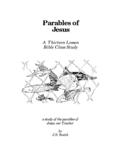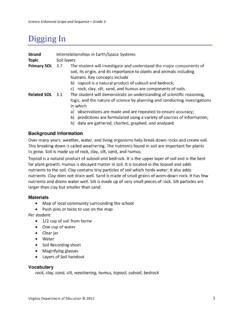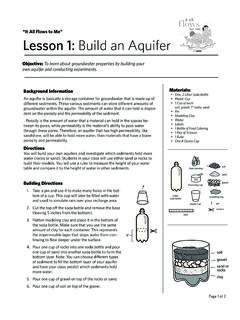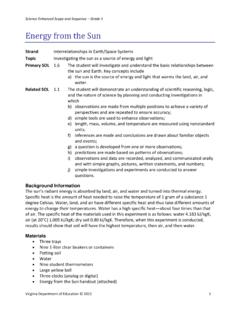Transcription of Teacher Resources: Lesson 3: Groundwater
1 Teacher Resources: Lesson 3: Groundwater Lesson # 3: Groundwater Driving Question: Where Does Water Come From & Where Does It Go? Learning Goal: The Groundwater system includes aquifers (rocks formations from which water can be withdrawn for use), springs, and the water table. Water moves underground through pore spaces and cracks in rocks and soil. (MEGOSE HS8, MCF(EH) ) A variety of factors affect aquifer/ Groundwater system characteristics, including rock/sediment type, permeability, depth, and thickness. Aquifers can be either confined (bounded above by impermeable layers) or unconfined (unbounded). Objectives: O4 Apply an understanding of permeability to explain the movements of Groundwater through confined and unconfined aquifers.
2 (using). O5 Develop/build models that explain how water moves through a Groundwater system and watershed (constructing). Assessment: A4 Given a stratigraphic cross-section of a Groundwater system, explain how a pollutant will affect different aquifers and wells. A5 Build a model and explain the movement of water through a watershed and through a Groundwater model. Lesson Purpose: This Lesson explores the question, "Where does water come from?" It connects to Lesson two by developing the Groundwater portion of the drinking water system. It also engages students in building models, model-based reasoning, and small group work. An important component of this Lesson is to develop an understanding of the relationship between Groundwater and lakes and rivers.
3 This understanding will be necessary for Lesson #4: Watersheds Lesson Overview: Activity Label Function Description Number Journal Questions Elicit Student Ideas / Students respond in journals to Establishes Purpose - This daily question. This activity is activity links to Lesson 2 by repeated each day of this exploring more in-depth Lesson , using different where and how we get our questions. water from the ground. What Does Water Elicit Student Ideas / Teacher presents question and Look Like Establishes Lesson Purpose elicits ideas - Where does Underground? - This activity establishes Lansing get its water? that this Lesson will help students understand where Students complete the "before Lansing gets its water. The side" of a T-chart drawing T-Chart elicits student ideas about where water is located underground Center for Curriculum Materials in Science Teacher Resources: Lesson 3: Groundwater Activity Label Function Description Number Permeability Construct Understanding - Students pour water on gravel This activity allows students and clay to see what happens to build an understanding of to the water.
4 Students learn the permeability. Students will definition of permeability. use the knowledge of permeability to understand aquifers (activities & ). Aquifers - what are Present Concepts - This Using an overhead, Teacher they? activity presents students briefly explains what an aquifer with concepts they will be is and the difference between exploring more in depth in confined and unconfined activity aquifers Soak Some Rocks Re-teach Optional Activity- Students find the mass of rocks, This activity may be useful to soak the rocks overnight, and demonstrate to students that then find the mass of the rocks water really does soak into the next day. Students should rocks. It is necessary only if find that the rocks soaked up students are having trouble water and have a greater mass.
5 Understanding that there are spaces within rocks where water can go. Building Construct Understanding/ Students build Groundwater Groundwater Developing Models - This models, from a given cross- Model activity engages students in section. The cross section is building a model of a drawn on 1/2 of a sheet of Groundwater system. It also paper. The top 1/2 of the paper introduces the idea of a shows a related map. Students cross-section and illustrates can fold the paper in half over the relationship between a the edge of a table to see the cross-section and a map. relationship between the map and cross-section. Exploring the Constructing Understanding/ Students pump water through Groundwater Inquiry Activity - This activity the Groundwater model, making Model engages students in making observations and noting observations and looking for patterns of water use.
6 The patterns in the way water materials will guide students to moves through a examine the connection Groundwater system, and between surface water and how Groundwater systems Groundwater . are connected to rivers and lakes. Center for Curriculum Materials in Science 2. Teacher Resources: Lesson 3: Groundwater Activity Label Function Description Number Well Problem: Formative Assessment/ Given a new map/cross-section, Where would you Model-Based Reasoning - students are asked to suggest a put a well? This activity assesses how location for a new well and well students understand the justify their answer based on relationship between surface the features on the map and water and Groundwater by cross-section. asking where a well should be drilled.
7 What Does It Look Apply Understanding/ Students use well-log data to Like Under Developing Models - This construct a x-section of the Lansing? Well Log activity addresses some of Lansing area. Cross-Section the same concepts learned in activities & However, it comes at the content from a slightly different angle. It also demonstrates how geologists use data to construct cross-sections, which are also models. Follow the Water Apply Understanding/ Model- Using the X-section drawn in Based Reasoning - This , students trace the path of activity requires students to hypothetical water molecules use the cross-section through the Groundwater models to solve problems. system, given different scenarios. Groups present their ideas on posters to the whole class.
8 Tracing Water Re-Teach Optional Activity This is a Teacher demonstration Paths in This is an opportunity for to help students understand the Groundwater students who are not path that water takes through a Models understanding how water Groundwater system. The moves through Groundwater Teacher adds dye to a systems to connect the idea Groundwater tank. The students of water moving through a watch the path that the water cross-section to water takes through the system and moving through the then draw the path on a cross- Groundwater model. section Surface Water or Return to Lesson Purpose Students read about where Groundwater ? This activity returns to the Grand Rapids gets its water Which is Better? Lesson purpose and explores and discuss pros and cons of other options for cities to get surface water vs.
9 Groundwater drinking water. It also for a domestic water supply. explores the pros- & cons of Groundwater vs. surface water. Center for Curriculum Materials in Science 3. Teacher Resources: Lesson 3: Groundwater Activity Label Function Description Number Finish T-Chart Lesson Assessment - This Students complete the T-Chart activity allows students to started in activity show what they learned about where water is located underground. It also allows students to compare what they have learned to their original ideas. Preconceptions: The research literature documents the following student ideas that are not congruent with a scientific understanding of Groundwater . This Lesson addresses these some of these preconceptions by building on student ideas.
10 The idea is to help students move their understanding towards a more scientific understanding, rather than simply correcting misconceptions. You should be aware of these preconceptions, but it does not mean that all of your students will hold these ideas. It is important for you to elicit your own students' ideas and build on their ideas during this unit. Common Desired Goal Activity that What to emphasize Preconception Visible Conception Addresses this in Drawings Preconception 1. Groundwater occurs in Ground water fills - Permeability Students can see water underground tanks or spaces between in the spaces between pipes the particles that the gravel grains. make up soil and Aquifers What are Teacher introduces the rock.








